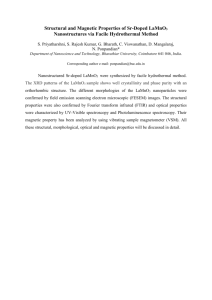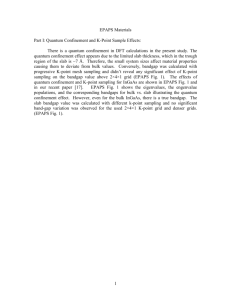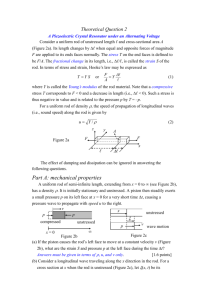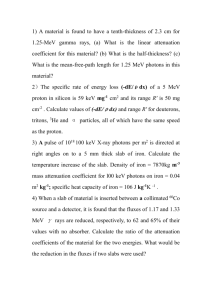surface paper Supporting Information
advertisement
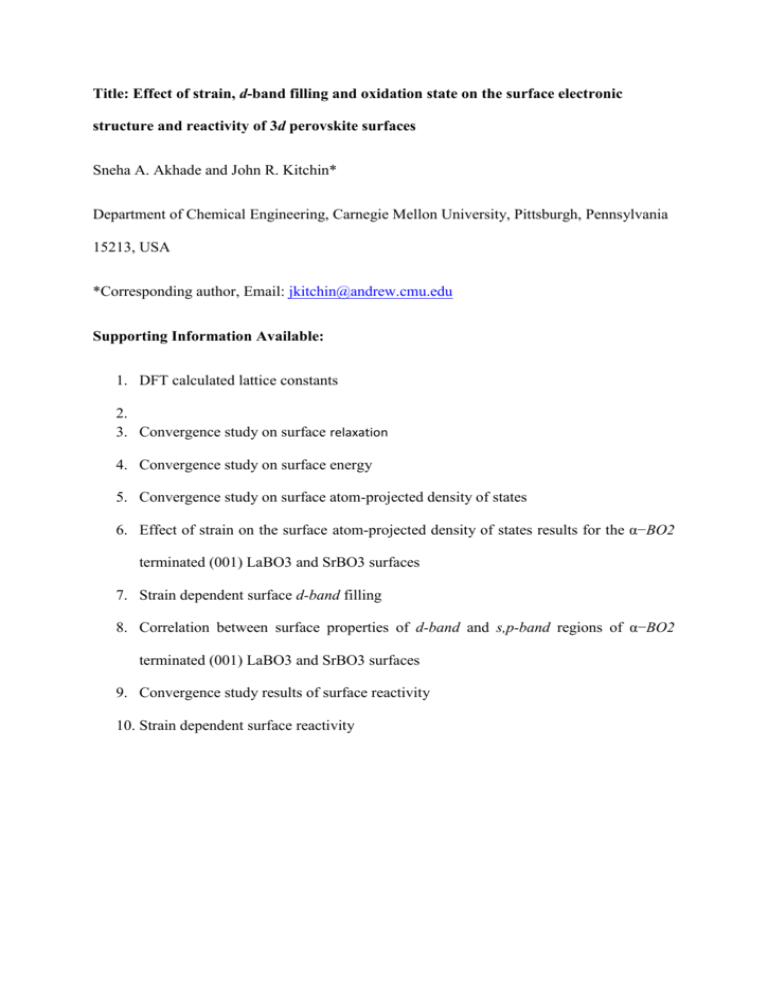
Title: Effect of strain, d-band filling and oxidation state on the surface electronic structure and reactivity of 3d perovskite surfaces Sneha A. Akhade and John R. Kitchin* Department of Chemical Engineering, Carnegie Mellon University, Pittsburgh, Pennsylvania 15213, USA *Corresponding author, Email: jkitchin@andrew.cmu.edu Supporting Information Available: 1. DFT calculated lattice constants 2. 3. Convergence study on surface relaxation 4. Convergence study on surface energy 5. Convergence study on surface atom-projected density of states 6. Effect of strain on the surface atom-projected density of states results for the α−BO2 terminated (001) LaBO3 and SrBO3 surfaces 7. Strain dependent surface d-band filling 8. Correlation between surface properties of d-band and s,p-band regions of α−BO2 terminated (001) LaBO3 and SrBO3 surfaces 9. Convergence study results of surface reactivity 10. Strain dependent surface reactivity 1. DFT calculated lattice constants The DFT calculated lattice constants for the construction of LaBO3 and SrBO3 surfaces were determined using the Murnaghan equation of state which employed a Monkhorst-Pack kpoint grid of 6×6×6 and a plane-wave cutoff of 400 eV. This is depicted in Table S 1. Table S 1. Calculated DFT lattice constants used in the construction of the LaBO3 and SrBO3 surfaces. Experimental Values Absolute Error Perovskite DFT values (Å) (Å) (Å) LaAlO3 3.78 3.80 0.02 LaScO3 4.05 3.94 0.11 LaTiO3 3.92 3.95 0.03 LaVO3 3.91 3.88 0.03 LaCrO3 3.87 3.85 0.02 LaMnO3 3.95 3.83 0.11 LaFeO3 3.92 3.83 0.09 LaCoO3 3.90 3.83 0.07 LaNiO3 3.88 3.84 0.04 LaCuO3 3.82 SrTiO3 3.94 3.91 0.03 SrVO3 3.84 3.84 0.00 SrCrO3 3.82 3.82 0.00 SrMnO3 3.81 3.81 0.01 SrFeO3 3.83 3.85 0.02 SrCoO3 3.82 3.84 0.02 SrNiO3 3.84 n/a n/a SrCuO3 3.92 3.93 0.00 Average Error (Å) = 0.08 2. Convergence study on surface relaxation Inter-atomic displacements were determined along the z-direction, while the coordinates of the atoms in the x- and y-directions remained unchanged since the slab was symmetric along the plane of the surface. As a result of geometric optimization, it was observed that most planes of the LaMnO3 surface slab exhibited “rumpling”. This essentially involved splitting of the planes. For the four layer (8-plane) α–MnO2 terminated LaMnO3 (001) surface undergoing top three layer relaxation, the –MnO2 planes were split such that the Mn atoms moved above the O atoms (see Figure S 1). Similarly, in case of –LaO planes, the La atoms moved above the O atoms. The Mn−O2 and La−O plane rumpling was quantified by calculating the inter-atomic displacement at each plane of the LaMnO3 surface. The pattern of atomic displacements due to relaxation-induced plane rumpling was observed for slabs of higher thicknesses as well. The magnitude of the Mn−O2 plane rumpling decreases as we progress from the −MnO2 terminated to −LaO terminated end of the (001) LaMnO3 slab. The same occurs for La−O. This suggests that the rumpling is prominently seen on the surface of the slab. In a study by Mastrikov and co-workers, comparable plane rumpling was reported on cubic and orthorhombic LaMnO3 surfaces of different Miller indices.1 Further, it was suggested that the plane rumpling of cubic surfaces could be checked by means of LEED experiments. The interplanar distance between O2−La and O−Mn is another way to quantify changes in the slab geometry. As shown in Figure S 1, the magnitude of the O2−La interplanar distance increases while proceeding from the −MnO2 terminated to −LaO terminated end of the (001) LaMnO3 slab. These results concurred with literature for similar calculations that were performed.1 The interplanar distances were calculated for slabs of higher thickness as well. The convergence study on surface relaxation considered two aspects. Surface relaxation calculations were tested for consistency in relation to the number of layers relaxed and the thickness of the slab. The relaxation caused rumpling of the surface that was quantitatively realized by calculating the atomic displacement within and between the atomic planes. Table S 2 shows the atomic plane splitting differences (Å) observed in MnO2 and LaO due to surface rumpling for an α−MnO2 terminated (001) LaMnO3 slab of varying thickness. It was observed that the plane rumpling distances decrease while proceeding from the −MnO2 terminated to −LaO terminated end of the (001) LaMnO3 slab. This was in accordance with literature results.2 However, the top α–MnO2 layer for slabs of varying thickness had a comparatively small MnO2 rumpling distance that is suggestive of strong compression of the top plane due to surface relaxation. The surface relaxation convergence was also tested using the inter-plane distances calculated using the atomic co-ordinates in the z-direction. Table S 3 shows the atomic interplane distances (Å) observed in O2−La and O−Mn for an α−MnO2 terminated (001) LaMnO3 slab of varying thickness. The interplanar distance for slabs of thickness greater than three layers was similar. This suggested that consistency was achieved in a four (or more) layer slab. Further consistency was achieved when these slabs had three or more layers relaxed. Thus for the purpose of reactivity and electronic structure calculations a four layer slab undergoing top two layer relaxation achieved sufficient convergence. Plane Plane rumpling (Å) Interplanar distance (Å) Mn (21.99) 1 0.08 Å MnO2 O2 (21.91) 1.57 Å (21.87) La (20.34) 2 0.31 Å LaO O (20.04) 1.93 Å (19.96) Mn (18.11) 3 0.07 Å MnO2 O2 (18.04) 1.70 Å (18.04) La (16.34) 4 0.15 Å LaO O (16.19) 1.90 Å (16.12) Mn (14.29) 5 0.07 Å MnO2 O2 (14.22) 1.78 Å (14.21) La (12.44) 6 0.1 Å LaO O (12.34) (12.29) 7 MnO2 MnO2 (10.38) 0Å 1.92 Å (Ideal) (10.38) 8 LaO LaO (8.46) 0Å Figure S 1. Schematic representation of planar rumpling due to top 3 layer surface relaxation on a 4 layer/8-plane α−MnO2 terminated (001) LaMnO3 surface. The arrows indicate the atomic displacement of the atoms in the z-direction from their original plane (shown on the left). The boxes include the atoms and their atomic coordinates (Å) in parentheses. The plane splitting difference of MnO2 and LaO and the interplanar difference between O2−La and O−Mn are shown on the right. Table S 2. Plane splitting distances (Å) between MnO2 and LaO for a multilayer relaxed α–MnO2 terminated LaMnO3 (001) slab of different slab thickness. Mn−O2 Top 2 layers relaxed Top 3 layers relaxed Top 4 layers relaxed Top 5 layers relaxed La−O 3 layer 4 layer 5 layer 6 layer 3 layer 4 layer 5 layer 6 layer -0.009 0.01 0.007 0.005 0.281 0.258 0.264 0.258 0.094 0.068 0.068 0.069 0.126 0.113 0.11 0.103 -0.004 0.007 0.006 0.308 0.294 0.289 0.077 0.074 0.074 0.152 0.133 0.137 0.072 0.057 0.056 0.100 0.073 0.072 0.003 0.006 0.314 0.282 0.085 0.085 0.157 0.139 0.074 0.07 0.124 0.101 0.026 0.011 0.083 0.054 0.005 0.301 0.083 0.164 0.075 0.128 0.024 0.107 0.023 0.073 Table S 3. Interplanar distances (Å) between O2−La and O−Mn for a multilayer relaxed α–MnO2 terminated LaMnO3 (001) slab of different slab thickness. The thickness of the slab varied between 6, 8, 10 or 12 planes. The atomic planes are numbered I through XII. Top 2 Top 3 Top 4 Top 5 Layers relaxed 6-plane 8-plane 10-plane 12-plane O2 (I)−La (II) 1.56 1.60 1.59 1.59 O2 (III)−La (IV) 1.71 1.76 1.76 1.76 O2 (V)−La (VI) 8-plane 10-plane 12-plane 10-plane 12-plane 12-plane .57 1.58 1.58 1.56 1.57 1.56 1.69 1.71 1.71 1.68 1.70 1.68 1.78 1.82 1.82 1.76 1.79 1.77 1.79 1.84 1.78 O2 (VII)−La (VIII) 1.99 O2 (IX)−La (X) O (II)−Mn (III) 1.88 1.93 .93 1.91 1.93 1.94 1.93 1.93 1.91 1.93 O (IV)−Mn (V) 1.95 1.94 1.93 1.92 1.90 1.90 1.90 1.90 1.90 1.90 1.97 1.94 1.93 1.95 1.94 1.94 1.92 1.90 1.91 O (VI)−Mn (VII) O (VIII)−Mn (IX) O (X)−Mn (XI) 1.92 3. Convergence study on surface energy The surface energy is defined as the energy required in creating a surface, i.e. to cleave a bulk material. This property can be determined based on the energy of the slab and the energy of the bulk material assuming that the obtained energies are well-converged for the set of parameters selected. The surface energy, σ, calculated for slabs of various thicknesses can be expressed as Equation S 1 where is the total energy of a symmetric slab (i.e. one with inversion symmetry, and where both sides of the slab have been relaxed), is the total energy of a bulk unit cell, is the number of atoms in the slab, and is the number of atoms in the bulk unit cell. The surface energy was computed for stoichiometric α–MnO2 terminated LaMnO3 (001) cubic slabs of different thicknesses (see Table S 4). The slabs were symmetrically relaxed on both the sides using Quasi-Newton geometric optimization algorithm. The calculations employed a plane-wave cutoff energy of 350 eV and a 4×4×1 Monkhorst-Pack kpoint grid. The surface energy of the relaxed slab (σ = ES) was compared with the corresponding surface energy of unrelaxed slab (σ = ESU) to study the surface energy convergence relative to the slab thickness. Table S 4. Calculated surface energies (eV/Å2) for the unrelaxed (ESU) and relaxed (ES) (001) cubic LaMnO3 surface slab of different thickness. The relaxation pattern depicts if the state of the layer is relaxed (R) or fixed (F). Nslab Relaxation pattern ESU (eV/Å2) ES (eV/Å2) Energy Ratio (ESU/ES) 3 4 5 5 6 6 R-F-R R-F-F-R R-F-F-F-R R-R-F-R-R R-F-F-F-F-R R-R-F-F-R-R 1.33 1.25 1.18 1.18 1.11 1.11 0.91 0.86 0.79 0.72 0.72 0.65 1.47 1.45 1.49 1.65 1.54 1.70 The relaxed surface energies (ES) were lower than the unrelaxed surface energies (ESU). It was noted that surface relaxation reduces the surface energy by an average factor of 1.55. In addition, relaxing a higher number of layers further reduced the relaxed surface energy (ES) resulting in a higher surface energy ratio. For example, in a six layer slab, there is an additional decrease of 0.14 eV/Å2 in the surface energy when four layers are relaxed instead of two layers. This compared well to literature where a surface energy ratio of 2 was reported based on the surface energies computed for an α–MnO2 terminated LaMnO3 (001) slab.3 The referenced calculations used an experimental bulk lattice constant of 3.95 Å and employed a plane-wave cutoff energy of 400 eV and a k-point mesh (based on the Monkhorst-Pack scheme) of 5×5×1. The magnitude of the relaxed surface energies decreases as the slab thickness increases. The value becomes constant for a slab of five layers (with relaxation pattern R-R-F-R-R) and for a slab of six layers (with relaxation pattern R-F-F-F-FR). This suggests that the relaxed surface energy is converged for slab thicknesses greater than four layers. This was in accordance with the literature results where the unrelaxed surface energy was reported to be 1.74 eV/Å2 for all slab thicknesses. 2 In our calculations however, the unrelaxed surface energy slightly varies with the slab thickness. This may be due to differences in the bulk lattice constant and the VASP parameters used in the literature. 4. Convergence study on surface atom-projected density of states The convergence of surface atom-projected density of states of LaMnO3 and SrMnO3 surfaces was tested relative to the Monkhorst-Pack k-point grid and the plane-wave cutoff energy (see Figure S 2). The states were obtained over a sufficiently large energy range of −10 to 10 eV to include contributions from all orbitals. Based on the convergence results, all further surface calculations were conducted using a Monkhorst-Pack k-point grid of 8×8×1 and a plane-wave cutoff of 450 eV. (a) LaMnO3 surface DOS at 400 eV cutoff and a Monkhorst-Pack k-point mesh of 6×6×1 (b) LaMnO3 surface DOS at 450 eV cutoff and a Monkhorst-Pack k-point mesh of 8×8×1 ɛ = +5% ɛ = +5% ɛ = +2.5% ɛ = +2.5% ɛ = 0% ɛ = 0% ɛ = −2.5% ɛ = −2.5% ɛ = −5% ɛ = −5% (c) SrMnO3 surface DOS at 400 eV cutoff and a Monkhorst-Pack k-point mesh of 6×6×1 (d) SrMnO3 surface DOS at 450 eV cutoff and a Monkhorst-Pack k-point mesh of 8×8×1 ɛ = +5% ɛ = +5% ɛ = +2.5% ɛ = +2.5% ɛ = 0% ɛ = 0% ɛ = −2.5% ɛ = −2.5% ɛ = −5% ɛ = −5% Figure S 2. Surface atom-projected density of states (DOS) for the Mn d-orbital (blue) and the O s, p-orbital (green) projections at different strains at the α−MnO2 terminated (001) LaMnO3 and SrMnO3 surfaces. The convergence calculations were tested relative to the and the plane-wave cutoff energy (eV) and the Monkhorst-Pack k-point grid. The shaded grey area indicates the occupied d-states up to the Fermi level (Ef). 5. Effect of strain on the surface atom-projected density of states results for the α−BO2 terminated (001) LaBO3 and SrBO3 surfaces The effect of strain on the surface electronic structure for various LaBO3 and SrBO3 (where B = Sc, Ti, V, Cr, Mn, Co, Ni and Cu) perovskites was computed using the atomprojected density of states of the 3d transition metal perovskite surfaces. The states were obtained using an infinite cutoff radius and employed a Monkhorst-Pack grid of 8×8×1 and a plane-wave cutoff of 450 eV. The d-band properties such as the d-band width (Wd) were evaluated using the results illustrated in Figure S 3. (a) LaScO3 ɛ = +5% ɛ = +2.5% ɛ = 0% ɛ = −2.5% ɛ = −5% (b) LaTiO3 (c) SrTiO3 ɛ = +5% ɛ = +5% ɛ = +2.5% ɛ = +2.5% ɛ = 0% ɛ = 0% ɛ = −2.5% ɛ = −2.5% ɛ = −5% ɛ = −5% (d) LaVO3 (e) SrVO3 ɛ = +5% ɛ = +5% ɛ = +2.5% ɛ = +2.5% ɛ = 0% ɛ = 0% ɛ = −2.5% ɛ = −2.5% ɛ = −5% ɛ = −5% (f) LaCrO3 (g) SrCrO3 ɛ = +5% ɛ = +5% ɛ = +2.5% ɛ = +2.5% ɛ = 0% ɛ = 0% ɛ = −2.5% ɛ = −2.5% ɛ = −5% ɛ = −5% (h) LaMnO3 (i) SrMnO3 ɛ = +5% ɛ = +5% ɛ = +2.5% ɛ = +2.5% ɛ = 0% ɛ = 0% ɛ = −2.5% ɛ = −2.5% ɛ = −5% ɛ = −5% (j) LaFeO3 (k) SrFeO3 ɛ = +5% ɛ = +5% ɛ = +2.5% ɛ = +2.5% ɛ = 0% ɛ = 0% ɛ = −2.5% ɛ = −2.5% ɛ = −5% ɛ = −5% (l) LaCoO3 (m) SrCoO3 ɛ = +5% ɛ = +5% ɛ = +2.5% ɛ = +2.5% ɛ = 0% ɛ = 0% ɛ = −2.5% ɛ = −2.5% ɛ = −5% ɛ = −5% (n) LaNiO3 (o) SrNiO3 ɛ = +5% ɛ = +5% ɛ = +2.5% ɛ = +2.5% ɛ = 0% ɛ = 0% ɛ = −2.5% ɛ = −2.5% ɛ = −5% ɛ = −5% (p) LaCuO3 (q) SrCuO3 ɛ = +5% ɛ = +5% ɛ = +2.5% ɛ = +2.5% ɛ = 0% ɛ = 0% ɛ = −2.5% ɛ = −2.5% ɛ = −5% ɛ = −5% Figure S 3. Atom-projected density of states (DOS) for the B d-orbital (blue line) and the O s, p-orbital (green dots) projections at different strains in the α−BO terminated (001) LaBO3 and SrBO3 surfaces using a 450 eV cutoff and a 8×8×1 Monkhorst-Pack k-point mesh. The shaded grey area indicates the occupied d-states up to the Fermi level (Ef). 6. Strain dependent surface d-band filling The surface d-band filling was calculated to be roughly constant for the α−BO2 terminated (001) LaBO3 and SrBO3 surfaces for all strains as shown in Figure S 4. (a) (b) LaScO3 LaCrO3 LaCoO3 1.2 LaTiO3 LaMnO3 LaNiO3 1.4 LaVO3 LaFeO3 LaCuO3 fractional d-band filling ratio (fd) fractional d-band filling ratio (fd) 1.4 1.0 0.8 0.6 0.4 0.2 0.0 SrTiO3 SrMnO3 SrNiO3 1.2 SrVO3 SrFeO3 SrCuO3 SrCrO3 SrCoO3 1.0 0.8 0.6 0.4 0.2 0.0 -5 -2.5 0 Strain ε (%) 2.5 5 -5 -2.5 0 2.5 Strain ε (%) Figure S 4. Strain dependence on the surface d-band filling (fd) of α−BO2 terminated (001) LaBO3 and SrBO3 perovskites at ±5, ±2.5 and 0% of the DFT equilibrium volume. 5 7. Correlation between surface properties of d-band and s,p-band regions of α−BO2 terminated (001) LaBO3 and SrBO3 surfaces (a) (b) 6 4 3 2 d-band center (Ed) 5 d-band center (Ed) 3 LaScO3 LaTiO3 LaVO3 LaCrO3 LaMnO3 LaFeO3 LaCoO3 LaNiO3 LaCuO3 1 SrTiO3 SrVO3 SrCrO3 SrMnO3 SrFeO3 SrCoO3 SrNiO3 SrCuO3 2 1 0 0 -1 -1 -7 -6 -5 -4 s,p-band center (Ep) -3 -6 -5 -4 -3 s,p-band center (Ep) -2 Figure S 5. Correlation between the d-band center (Ed) and s, p-band center (Ep) for the α−BO2 terminated (001) (a) LaBO3 and (b) SrBO3 surfaces at varying strain. 8. Convergence study results of surface reactivity The convergence study on surface reactivity of α−MnO2 terminated (001) LaMnO3 and SrMnO3 surfaces were tested for consistency in relation to the plane-wave cutoff energy (eV) and Monkhorst-Pack k-point grid (shown in Figure S 6 and Figure S 7). Table S 5 and Table S 6 show the computed energies achieve consistency at a plane-wave cutoff energy of 450 eV and a Monkhorst-Pack k-point grid of 8×8×1. The converged parameters accounted for the accuracy of the converged calculation (less than ±50 meV) as well as the time and expense of the computational resources. The parameters were employed for all further surface reactivity calculations of 3d LaBO3 and SrBO3 perovskites (where B = Sc, Ti, V, Cr, Mn, Fe, Co, Ni, Cu). (a) (b) 4.5 0.0 pw = 300 eV pw = 350 eV pw = 400 eV pw = 450 eV 4.0 Evac (eV) ∆Hads (eV) -1.0 -2.0 3.5 pw = 300 eV pw = 350 eV pw = 400 eV pw = 450 eV 3.0 -3.0 -5 -2.5 0 Strain ε (%) 2.5 -5 5 (c) -2.5 0 Strain ε (%) 2.5 5 (d) 4.5 0.0 kpts 4x4x1 kpts 6x6x1 kpts 8x8x1 kpts 4x4x1 kpts 6x6x1 kpts 8x8x1 Evac (eV) ∆Hads (eV) -1.0 4.0 -2.0 3.5 -3.0 -5 -2.5 0 Strain ε (%) 2.5 5 -5 -2.5 0 Strain ε (%) 2.5 5 Figure S 6. Convergence results of α−MnO2 terminated (001) LaMnO3 surface reactivity relative to (a) (b) plane-wave cutoff energy and (c) (d) Monkhorst-Pack k-point grid. (a) (b) 0.0 3.5 pw = 300 eV pw = 350 eV pw = 400 eV pw = 450 eV Evac (eV) ∆Hads (eV) -0.5 3.0 pw = 300 eV -1.0 pw = 350 eV 2.5 -1.5 -5 -2.5 0 Strain ε (%) 2.5 -5 5 (c) -2.5 0 Strain ε (%) 2.5 5 (d) 0.0 3.5 kpts 4x4x1 kpts 6x6x1 kpts 8x8x1 Evac (eV) ∆Hads (eV) -0.5 3.0 -1.0 kpts 4x4x1 kpts 6x6x1 kpts 8x8x1 -1.5 -5 -2.5 0 Strain ε (%) 2.5 5 2.5 -5 -2.5 0 Strain ε (%) 2.5 5 Figure S 7. Convergence results of α−MnO2 terminated (001) SrMnO3 surface reactivity relative to (a) (b) plane-wave cutoff energy and (c) (d) Monkhorst-Pack k-point grid. Table S 5. Convergence results of surface oxygen dissociative adsorption energy (∆Hads) and vacancy formation energy (Evac) of the α−MnO2 terminated (001) LaMnO3 surface relative to the (a) plane-wave cutoff energy (eV) at a k-point grid of 4×4×1 (eV) and (b) Monkhorst-Pack k-point grid at a cutoff energy of 350 eV. Strain ɛ -5 -2.5 0 2.5 5 -5 -2.5 0 2.5 5 (%) Dissociative adsorption energy ∆Hads (eV) (a) (b) 300 350 400 450 4×4×1 6×6×1 8×8×1 -2.42 -2.39 -2.34 -2.3 -2.39 -2.23 -2.23 -2.3 -2.28 -2.07 -2.11 -2.28 -2.1 -2.09 -1.93 -1.94 -1.92 -1.93 -1.94 -1.84 -1.84 -1.79 -1.74 -1.79 -1.81 -1.74 -1.75 -1.75 -1.84 -1.74 -1.77 -1.79 -1.74 -1.74 -1.74 Surface vacancy formation energy Evac (eV) 3.79 3.73 3.82 3.81 3.73 3.85 3.8 3.85 3.79 3.86 3.86 3.79 3.99 3.97 4.02 3.95 3.91 3.89 3.95 4.09 4.07 4.1 4.06 4.00 3.99 4.06 4.12 4.1 4.17 4.13 4.11 4.09 4.13 4.18 4.16 Table S 6. Convergence results of surface oxygen dissociative adsorption energy (∆Hads) and vacancy formation energy (Evac) of the α−MnO2 terminated (001) SrMnO3 surface relative to the (a) plane-wave cutoff energy (eV) at a k-point grid of 4×4×1 and (b) Monkhorst-Pack k-point grid at a cutoff energy of 350 eV. Strain ɛ -5 -5 0 2.5 5 -5 -2.5 0 2.5 5 (%) Dissociative adsorption energy Surface vacancy formation ∆Hads (eV) energy Evac (eV) (a) (b) 300 350 400 450 4×4×1 6×6×1 8×8×1 -0.95 -0.91 -0.94 -0.94 -0.91 -0.86 -0.89 -0.88 -0.85 -0.86 -0.86 -0.85 -0.80 -0.81 -0.89 -0.80 -0.92 -0.94 -0.87 -0.84 -0.85 -1.01 -0.98 -1.01 -1.02 -0.98 -0.97 -0.97 -1.14 -1.10 -1.15 -1.20 -1.10 -1.11 -1.11 3.34 3.28 3.25 3.25 3.28 3.11 3.15 3.29 3.23 3.21 3.21 3.23 3.15 3.14 3.13 3.08 3.05 3.05 3.08 3.05 3.03 3.07 3.03 3.00 2.99 3.03 3.04 3.03 3.16 3.13 3.11 3.07 3.13 3.14 3.14 9. Strain dependent surface reactivity The strain dependent surface oxygen dissociative adsorption energies of the α−BO2 terminated (001) LaBO3 and SrBO3 surfaces are shown in Table S 7 and Table S 8. The energies were computed for surfaces with the top two layers relaxed. Table S 7. Strain dependent surface oxygen dissociative adsorption energy (∆Hads) of the α−BO2 terminated (001) (a) LaBO3 and (b) SrBO3 surfaces with top two layers relaxed. Strain ɛ (%) (a) -5 -2.5 0 2.5 5 Surface oxygen dissociative adsorption energy ∆Hads (O) LaScO3 LaTiO3 LaVO3 LaCrO3 LaMnO3 LaFeO3 LaCoO3 LaNiO3 LaCuO3 0.86 1.65 2.21 2.53 2.65 -4.80 -4.26 -3.94 -3.74 -3.62 -4.20 -3.87 -3.65 -3.5 -3.42 -3.29 -3.00 -2.87 -2.77 -2.78 -2.27 -2.01 -1.89 -1.83 -1.8 -1.20 -1.40 -0.9 -0.83 -0.75 -0.19 -0.13 -0.08 0.08 0.05 1.20 1.22 1.18 1.11 1.02 2.68 2.74 2.70 2.61 2.49 SrTiO3 SrVO3 SrCrO3 SrMnO3 SrFeO3 SrCoO3 SrNiO3 SrCuO3 1.70 2.10 2.05 1.94 2.07 -2.82 -2.42 -2.24 -2.26 -2.40 -2.04 -1.80 -1.70 -1.77 -1.93 -0.93 -0.85 -0.92 -1.01 -1.17 0.01 0.06 0.01 0.00 -0.12 0.59 0.69 0.65 0.76 0.62 1.35 1.43 1.44 1.43 1.24 2.78 2.64 2.53 2.41 2.29 (b) -5 -2.5 0 2.5 5 Table S 8. Strain dependent surface oxygen vacancy formation energy (Evac) of the α−BO2 terminated (001) (a) LaBO3 and (b) SrBO3 surfaces with top two layers relaxed. Strain ɛ (%) (a) -5 -2.5 0 2.5 5 (b) -5 -2.5 0 2.5 5 Surface oxygen vacancy formation energy Evac(O) LaScO3 LaTiO3 LaVO3 LaCrO3 LaMnO3 LaFeO3 LaCoO3 LaNiO3 LaCuO3 3.94 4.26 4.73 4.82 4.51 5.43 5.80 6.02 6.16 6.22 4.95 5.20 5.42 5.54 5.55 4 50 4.63 4.69 4.79 4.83 3.80 3.95 3.97 4.00 4.12 2.88 2.96 3.04 2.91 3.00 2.21 2.23 2.26 2.10 2.11 1.58 1.62 1.62 1.62 1.67 0.49 0.62 0.67 0.72 0.75 SrTiO3 SrVO3 SrCrO3 SrMnO3 SrFeO3 SrCoO3 SrNiO3 SrCuO3 4.83 5.06 5.13 5.11 5.39 4.63 4.76 4.78 4.78 4.80 3.94 3.99 3.95 3.92 3.95 3.09 3.09 3.01 3.00 3.11 1.84 1.91 1.89 2.06 2.20 0.80 0.92 0.96 1.25 1.38 -0.26 -0.08 0.09 0.36 0.15 -0.88 -0.74 -0.64 -0.60 -0.59 References: 1. 2. 3. Y. A. Mastrikov, E. Heifets, E. A. Kotomin and J. Maier, Surface Science 603 (2), 326-335 (2009). R. A. Evarestov, E. A. Kotomin, Y. A. Mastrikov, D. Gryaznov, E. Heifets and J. Maier, Physical Review B 72 (21), 214411 (2005). E. A. Kotomin, R. A. Evarestov, Y. A. Mastrikov and J. Maier, Physical Chemistry Chemical Physics 7 (11), 2346-2350 (2005).
